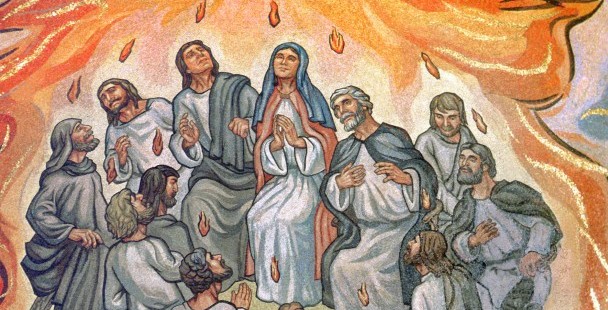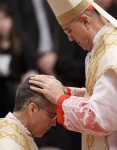



Vatican II: The Holy Spirit in the rites of Ordination
Warren Schmidt
Wednesday, February 6, 2013

As I begin writing this, I can say that my preparation for an early autumn 2013 profession of perpetual vows and ordination to the diaconate has officially begun, with the blessing of my religious Congregation, the Basilian Fathers.
My Basilian journey, which began with my Associate year in 2007-2008, and the coming months of preparation to be perpetually professed and ordained a deacon, has been and will be a Spirit-filled journey. In this year commemorating the 50th anniversary of the Second Vatican Council, I can not help but think about how the council shaped the sacrament I will soon be receiving.
It has been said by some that our Roman tradition is sometimes insufficiently attentive to the action of the Holy Spirit. Vatican II took steps to rectify this problem, with the notable pneumatological* influence of Eastern Christianity. The Council formally opened on 11 October 1962 with a lengthy prayer to the Holy Spirit: “We stand before you, Holy Spirit, conscious of our sinfulness, but aware that we gather in your name. Come to us, remain with us, and enlighten our hearts...”
Vatican II led to post-Conciliar revisions, not only to the Order of Mass, but to each of the Sacramental rites. I want to focus on the rite of the Sacrament of Orders, not only because I will be receiving this sacrament, but also because Orders is the most recent Sacrament whose rites took the form we know today (latest revision in 1990).
Three rites exist for the Sacrament of Holy Orders, since this Sacrament has three degrees: episcopal (bishops), presbyteral (priests), and diaconal (deacons).
In the rite of ordination of deacons, the words of the prayer of consecration that are required for the validity of the Sacrament are thus:
 Of course, Confirmation is connected with Baptism, in which one is initiated into the Church and then anointed, “by water and the Holy Spirit.” Diaconal ordination, then, most intimately links the deacon with the body of the baptized to which he belongs and is ordained to serve.
The reference to the Holy Spirit in the rite of consecration of a deacon, appropriately, is preceded the mention of two other things that further emphasize the relationship among the diaconal order, Christian initiation, and service of the immediate needs of the faithful:
Of course, Confirmation is connected with Baptism, in which one is initiated into the Church and then anointed, “by water and the Holy Spirit.” Diaconal ordination, then, most intimately links the deacon with the body of the baptized to which he belongs and is ordained to serve.
The reference to the Holy Spirit in the rite of consecration of a deacon, appropriately, is preceded the mention of two other things that further emphasize the relationship among the diaconal order, Christian initiation, and service of the immediate needs of the faithful:
Lord, send forth upon him the Holy Spirit, that he may be strengthened by the gift of your sevenfold grace to carry out faithfully the work of the ministry.This mention of the Holy Spirit connects the ordination of a deacon with the Sacrament of Confirmation, in which the bishop or his delegate priest prays for the confirmand to receive the seven gifts of the Holy Spirit: wisdom, understanding, right judgment, courage, knowledge, reverence and wonder and awe in God’s presence.”
 Of course, Confirmation is connected with Baptism, in which one is initiated into the Church and then anointed, “by water and the Holy Spirit.” Diaconal ordination, then, most intimately links the deacon with the body of the baptized to which he belongs and is ordained to serve.
The reference to the Holy Spirit in the rite of consecration of a deacon, appropriately, is preceded the mention of two other things that further emphasize the relationship among the diaconal order, Christian initiation, and service of the immediate needs of the faithful:
Of course, Confirmation is connected with Baptism, in which one is initiated into the Church and then anointed, “by water and the Holy Spirit.” Diaconal ordination, then, most intimately links the deacon with the body of the baptized to which he belongs and is ordained to serve.
The reference to the Holy Spirit in the rite of consecration of a deacon, appropriately, is preceded the mention of two other things that further emphasize the relationship among the diaconal order, Christian initiation, and service of the immediate needs of the faithful:
You enable your Church, Christ’s body, to grow to full stature as a new temple... formed into a wonderful pattern of unity by the Holy Spirit... And so, in the first days of your Church, through the inspiration of the Holy Spirit, your Son’s Apostles appointed seven men of good repute [see Acts 6:3] to assist them in the daily ministry...Like the rite of diaconal ordination, the rite of ordination to priesthood makes clear, in terms of the Holy Spirit’s work, the connection between the new priest and the faithful he is to lead and to empower:
Almighty Father, grant, we pray, to these servants of yours the dignity of the priesthood. Renew deep within them the Spirit of holiness... By their manner of life, may they be examples of right conduct. May they be worthy coworkers with the Order of Bishops, so that by their preaching and through the grace of the Holy Spirit, the words of the Gospel may bear fruit in human hearts and reach even to the ends of the earth.On one hand, the “Spirit of holiness” which the ordaining bishop calls on to renew "deep within" the new priest, is the same Spirit who continually renews the call to holiness applicable to all Christians. On the other hand, if we understand the prayer of consecration of a priest linguistically (“Spirit of holiness” derives from the Latin, “spiritus consilii,” or Spirit of counsel), priests share in the Spirit in the counsel, or good judgment, of the “order of bishops.” A priest, then, is a bridge between all the faithful, inspired by the Holy Spirit to live the universal call to holiness, and bishops, inspired by the same Spirit to govern the Church. The rite of ordination of a bishop reinforces this unity in the Holy Spirit:
So now pour out upon this chosen one the power that is from you, the governing Spirit whom you gave to your beloved Son, Jesus Christ; the Spirit given by him to his holy apostles, who founded the Church in every place to be your temple for the unceasing glory and praise of your name.As such, the bishop, who governs in communion with his brother bishops and the head of the College of Bishops, the Pope, is united also with priests. In turn, priests are inspired by the Spirit of holiness to which all are called. Deacons in particular are ordained to serve the more direct needs of the faithful, lay and ordained, by disseminating upon the world the manifold yet interrelated gifts of the Holy Spirit, who is forever one God with the Father and the Son. - * pneumatological comes from the Greek pneuma: breath, wind, spirit; and legein: to speak Top: CNS photo/Crosiers Inset: CNS/Paul Haring
Related Articles:
<<
SUPPORT LABEL
$50
$100
$150
$250
OTHER AMOUNT
DONATE
Receive our newsletters
Stay Connected
Receive our newsletters

Stay Connected







